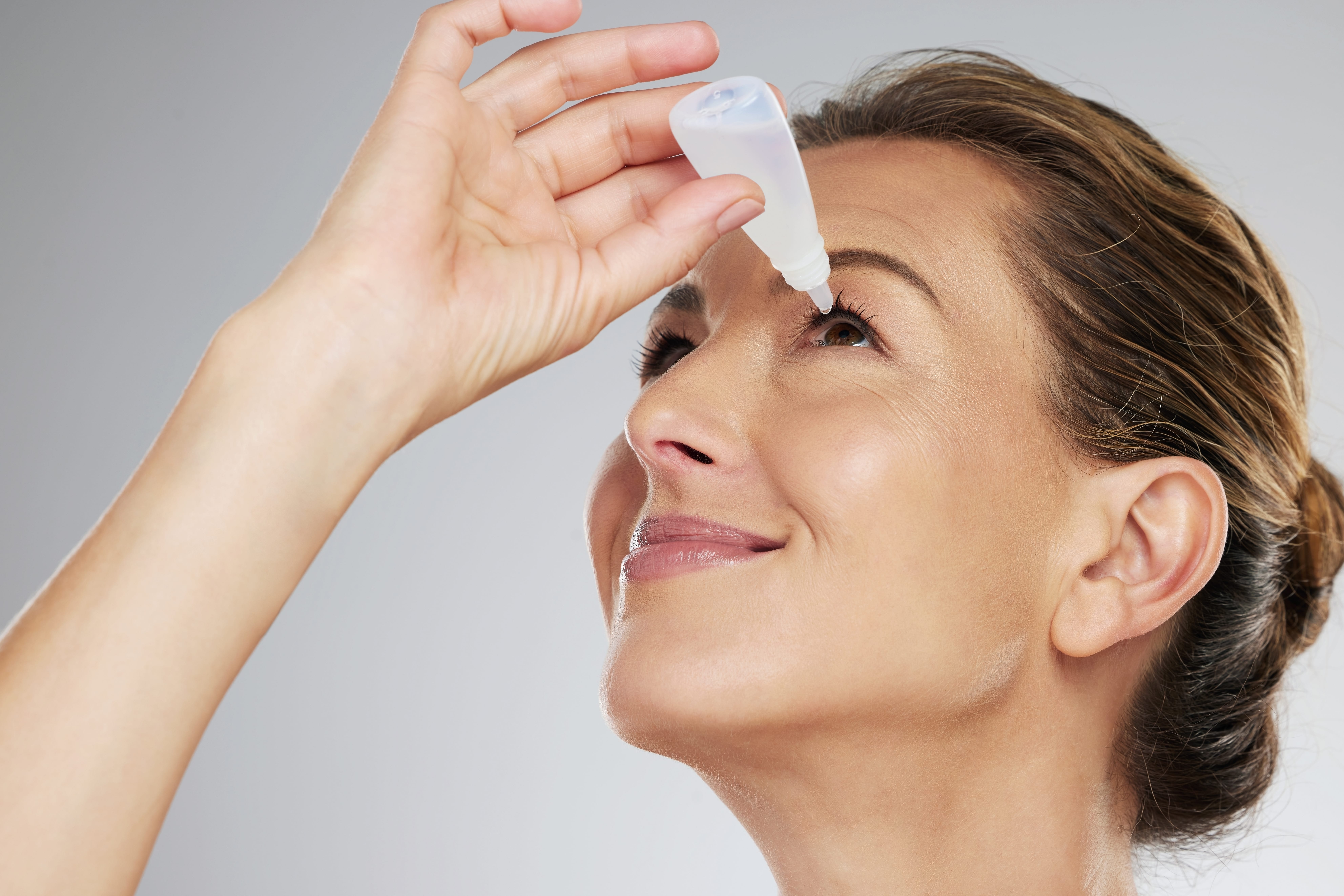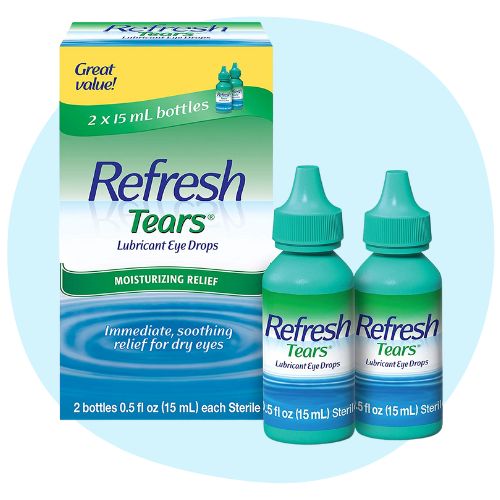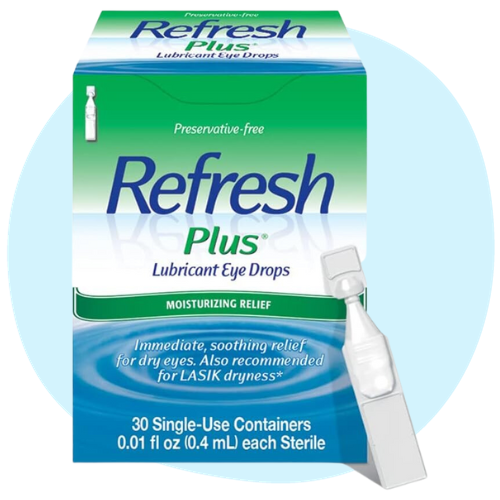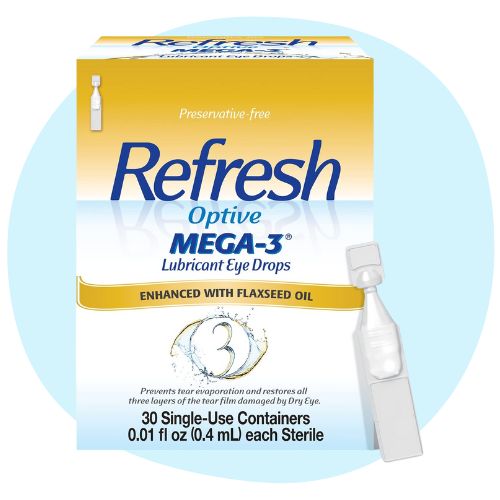Updated on January 30, 2025
The 8 Best Eye Drops for Dry Eyes


Vision Center is funded by our readers. We may earn commissions if you purchase something via one of our links.
Everything We Recommend
Best Budget (Basic Option): Refresh Tears Lubricant Eye Drops
Best Preservative-Free Eye Drops: Refresh Plus Lubricant Eye Drops, Preservative-Free
Best for Mild Dry Eye: Systane Long Lasting Lubricant Eye Drops
Best for Severe Dry Eye: Systane Lubricant Eye Gel Drops
Best for Contacts: Opti-Free Replenish Rewetting Drops
Best for Allergy Relief: Zaditor Antihistamine Eye Drops
Best for Red Eyes: LUMIFY Redness Reliever
Best for MGD: Refresh Optive Mega-3 Lubricant Eye Drops, Preservative-Free or See Your Doctor
Best Eye Drops (Artificial Tears) for Dry Eyes
Nearly everyone experiences dry eyes at some point in their lives. Eye drops are a safe and effective treatment for most dry eye cases.
However, not all eye drops are the same. Lubricating eye drops, or artificial tears, are specially formulated to relieve dry eye symptoms.

Here are the eight best eye drops for dry eyes, along with the best drops to treat allergies or redness.
8 Best Eye Drops for Dry Eyes
Best Budget (Basic Option): Refresh Tears Lubricant Eye Drops

Refresh Tears Lubricant Eye Drops provide instant relief for dry and irritated eyes. Formulated with ingredients similar to natural tears, they moisturize and soothe the eyes effectively.
The multi-dose bottle is convenient and can be used as frequently as required. It is also safe to be used with contact lenses.
What Customers Are Saying:
- Many reviews state that they achieve more comfort after using these eye drops
- A few talked about how these eye drops offer great value for the price
- Some customers didn’t feel a big difference after using the eye drops
- Others feel like these eye drops didn’t moisten their eyes enough
Best Preservative-Free Eye Drops Refresh Plus Lubricant Eye Drops, Preservative-Free

Refresh Plus Preservative-Free Lubricant Eye Drops provide instant relief for dry and irritated eyes. It has active ingredients like Carboxymethylcellulose sodium to produce artificial tears. The drops come in single-use vials and can be used safely with contact lenses as often as needed.
What Customers Are Saying:
- Customers like this product’s packaging because it’s more convenient and feels more sterile
- The eye drops offer instant relief for people experiencing eye irritation
- While many praise the packaging, others find it uncomfortable, especially if the vial gets too close to the eyes
- Some don’t like their experience using the product since the effects don’t last as long
Best for Mild Dry Eye: Systane Long Lasting Lubricant Eye Drops

Systane Lubricant Eye Drops provide relief from dry eye symptoms. Clinically proven to reduce signs and symptoms of dry eye, the original formula offers immediate and long-lasting moisture and protection.
The Systane brand is one of the top doctor-recommended brands of artificial tears for dry eye symptom relief.
What Customers Are Saying:
- Many reviews talk about how this product offers great relief for people with dry eye symptoms
- The drops provide long-lasting effects and are a good value for money
- Some negative reviews talk about how these eye drops made their vision more blurry
- A few reviews talk about the drops making their eyes more dry than moisturized
Best for Severe Dry Eye: Systane Lubricant Eye Gel Drops

With its thick, protective formulation, SYSTANE® Gel Drops offer lasting relief from dry eye irritation. These gel drops provide the best of both worlds, combining the ease of use of traditional eye drops with added gel protection.
What Customers Are Saying:
- The drops provide a soothing effect on the eyes, relieving dry eyes
- The product is very versatile since it provides relief for different kinds of eye issues as well
- Since it’s a gel formula, the initial application can be too thick for the eyes
- Some reviews say that these eye drops didn’t work for them and didn’t provide any relief
Best for Contacts: Opti-Free Replenish Rewetting Drops

Opti-Free Replenish Rewetting Drops are a safe and effective solution for providing constant moisture for various types of contact lenses. They can help prevent protein buildup and remove materials that may cause irritation and discomfort.
These drops differ from other Opti-Free solutions in that they’re intended for direct application to the eye instead of being used to soak the lens alone.
What Customers Are Saying:
- A lot of reviews talk about how effective the solution is for keeping the eyes moisturized and comfortable when wearing lenses
- The packaging is sturdy, so it’s convenient enough to bring while traveling
- While there are several positive reviews, some say that these drops make their contact lenses more dry
- Some say that there are more affordable options on the market aside from these eye drops
Best for Allergy Relief: Zaditor Antihistamine Eye Drops

Systane Zaditor Antihistamine Eye Drops offer effective relief from itchy eyes caused by allergens. This prescription strength formula is a triple-action solution that works quickly, providing up to 12 hours of relief.
Unlike oral medications, it targets the source of the itch directly. Adults and children over the age of 3 can use this product.
What Customers Are Saying:
- Many reviews say that these eye drops are effective for providing relief from allergy-related symptoms like itchiness and watery eyes
- The product has long-lasting effects and requires less frequent application
- Some customers say that the drops didn’t work as well for their allergies as they hoped
- Others find the drops quite expensive compared to other similar options on the market
Best for Red Eyes: LUMIFY Redness Reliever

LUMIFY, an FDA-approved eye drop formula developed by doctors, quickly reduces redness and improves the appearance of eyes by making them appear brighter and more radiant. Its clinically proven effectiveness lasts up to 8 hours with a lower risk of side effects, thanks to its unique method of selectively targeting redness.
What Customers Are Saying:
- Many positive reviews talk about how the drops offer quick results, instantly relieving dry eyes
- The drops not only relieve dry eyes but also make the eyes appear brighter and more vibrant
- A few customers expressed that these eye drops are expensive since the bottle contains too little product for the price
- Some users report a few side effects when using these drops
Best for MGD: Refresh Optive Mega-3 Lubricant Eye Drops, Preservative-Free

Refresh Optive Mega-3, a preservative-free, low-blur formula, offers a unique combination of flaxseed and castor oils that helps keep the tear film intact.
This innovative solution is clinically proven to alleviate the discomfort associated with dry eye, a condition frequently caused by Meibomian Gland Dysfunction (MGD). The product also nourishes all three tear film layers for long-lasting relief.
What Customers Are Saying:
- Customers like how these eye drops are preservative-free since it helps prevent any side effects
- The single-use vials are convenient and can reduce the risk of contamination
- A few customers expressed quality control issues when they received the product, such as broken or opened boxes
- Multiple users have reported eye irritation and issues after using these eye drops, like hazy vision or eyes sticking together
Types of Eye Drops for Dry Eyes
Many cases of dry eye disease can be solved with OTC drops. Most of these cases are caused by environmental factors or MGD.
MGD, or meibomian gland dysfunction, is a blockage and inflammation of meibomian glands. Meibomian glands produce oils that cover your eyes and hold moisture in.
If over-the-counter (non-prescription) drops aren’t solving your dry eye problems, you may have MGD. There are several treatment options for MGD. Speak with your doctor to find the right treatment for you.
The different types of eye drops for dry eyes include:
1. Non-Prescription Eye Drops
Non-prescription lubricating eye drops can treat most cases of mild to moderate dry eye. If environmental factors cause dry eyes, you should start with these eye drops.
There are two general OTC eye drops: eye drops with preservatives and those without preservatives.
Non-prescription drops may be traditional eye drops, gels, or ointments. Gels and ointments tend to stay in your eyes longer. They are recommended for overnight use.
Eye Drops With Preservatives
Many eye drops contain preservatives to make the solution last longer. These eye drops are cheaper and more convenient than those without preservatives. These drops may be sufficient for contact lens wearers with mild dry eyes.
However, some people find that preservatives irritate their eyes. You should avoid eye drops with preservatives if:
- These types of drops irritate your eyes
- You apply eye drops four or more times per day
- Your dry eyes are moderate to severe
Eye Drops Without Preservatives
Eye drops without preservatives are less irritating. They can be applied many times a day.
However, these eye drops are more expensive and inconvenient than those with preservatives. They usually come in single-use doses rather than a bottle or vial.
Preservative-free eye drops are recommended if you apply eye drops four or more times a day or regular eye drops irritate your eyes.
2. Prescription Eye Drops
Prescription eye drops are only available from your doctor. They are used to treat:
- Meibomian gland dysfunction (MGD)
- Keratoconjunctivitis sicca (dry eye syndrome)
- Chronic dryness
- Eye infections
If non-prescription eye drops do not treat your symptoms, visit your eye doctor.
Other Home Remedies & Tips for Dry Eyes
In addition to eye drops, there are other ways to help relieve dry eyes and improve eye health. These include:
1. Warm Compresses
Wet a washcloth with warm water, wring it out, and place it on your eyes for at least one minute. Then, remove the compress and gently press the edge of your eyelid to squeeze out clogged oils. This can help unclog your oil-making glands.
2. Eyelid & Eyelash Hygiene
Makeup, skin treatments, and certain conditions can also contribute to dry eyes. Clean your eyelids and eyelashes daily, as well as the skin and hair around your eyes. This can help reduce lid inflammation.
3. The 20-20-20 Rule
This helps if your dry eyes are related to working on the computer or doing other deep-focus tasks. Long-term use of digital devices may contribute to blurry vision. Every 20 minutes, stop and stare at an item 20 feet away for 20 seconds.
4. Stay Hydrated
Drinking plenty of water is essential to keep your body functioning. Your eyes and tears need this hydration. Make sure to drink 6 to 8 glasses of water each day.
5. Wear Wraparound Sunglasses
If your dry eyes are the result of windy, sandy, dusty, or polluted conditions, sunglasses can help. Wearing wraparound sunglasses protects your eyes and keeps them from drying out.
Other Types of Eye Drops
Several other types of eye drops are made to treat other problems besides dry eye. These include:
1. Rewetting Eye Drops
Rewetting drops provide relief for dryness and discomfort from wearing contact lenses.
Not all lubricating eye drops are compatible with contact lenses. You may need to remove your contacts before applying them.
If your contact lenses are causing dry eye or discomfort, rewetting drops may help. However, contact your doctor if you believe your eye dryness is caused by something else.
Read about the best eye drops for contact lenses.
2. Decongestant (Whitening) Eye Drops
Decongestant eye drops treat red eyes. They contain active ingredients like vasoconstrictors, which shrink the blood vessels in your eye, reducing redness.
Decongestant eye drops do not treat dry eyes. In fact, they can irritate your eyes if you use them too much. Additionally, your eyes can get dependent on them.
You should only use decongestant eye drops intermittently. They are made to improve the appearance of your eyes, not treat any eye conditions.
3. Antihistamine (Allergy) Eye drops
Antihistamine eye drops treat itchy, watery, red eyes caused by allergic reactions. Common allergens include pollen, pets, and mold, among others.
When your body has an allergic reaction, it releases histamines. These cause allergy symptoms such as runny nose, itchy eyes, etc.
Active ingredients in allergy eye drops are antihistamines. Therefore, antihistamine eye drops are only effective at treating symptoms due to allergies.
Read more about antihistamine eye drops.
4. Antibiotic/Antibacterial Eye Drops
Antibiotic (antibacterial) eye drops treat bacterial eye infections. Common eye infections include conjunctivitis (pink eye), contact lens infections, and styes.
Lubricating eye drops can help relieve symptoms of infections. However, they don’t cure them. If you have an eye infection, it’s best to speak with an eye doctor before purchasing any eye drops.
Read more about antibiotic eye drops.
Why You Can Trust Our Recommendations
Here’s why you can trust Vision Center’s recommendations:
1. Vision Experts
Vision Center is a leading and trusted online resource for vision health. We research information about vision, including product recommendations, primary vision care, procedures, costs, and more.
Our team consists of dedicated medical writers, expert researchers, professionals, and medical reviewers. We all work together to create and oversee every piece of content published on our site.
2. Extensive Research and Testing
Another reason why you can trust Vision Center’s recommendations is because we conduct extensive research and training. Here are some highlights of our research process:
- Consulting with our in-house eye doctors
- Reading through hundreds of customer reviews from multiple sources
- Personally testing some of our product recommendations
- Spent hundreds of hours researching different products, including their safety and efficacy
3. Comprehensive Review Process
After extensive research and product testing, this article also underwent an intensive review process:
- Had our two editors read the article and check the facts in it.
- One of our medical experts looked at the article to ensure accuracy.
- We also regularly update the article to ensure the prices, product information, and other details are still right.
Summary
- Eye drops help overcome dry eye symptoms and other eye diseases.
- You can get them over the counter, but other eye drops require a prescription.
- Our recommendations above can help you choose the best drops for your needs.
- Always follow your doctor's advice and product instructions when using any eye drops.
In this article
6 sources cited
Updated on January 30, 2025
Updated on January 30, 2025
About Our Contributors
Michael, a lead content writer for Vision Center, brings eight years of experience in medical copywriting and advanced research methodologies. With a B.A. in English and Linguistics from the University at Buffalo, he specializes in creating detailed, evidence-based content, particularly in the field of eye health, to educate readers and guide them toward appropriate treatments.
Dr. Melody Huang is an optometrist and freelance health writer with a passion for educating people about eye health. With her unique blend of clinical expertise and writing skills, Dr. Huang seeks to guide individuals towards healthier and happier lives. Her interests extend to Eastern medicine and integrative healthcare approaches. Outside of work, she enjoys exploring new skincare products, experimenting with food recipes, and spending time with her adopted cats.

